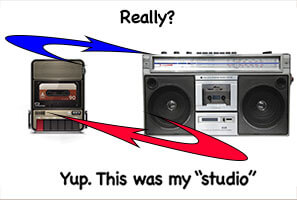 I started recording myself playing music before people had computers in their homes (with the exception of a few friends whose parents bought them an Apple 2 – not that I am bitter:)). Being a teenager and unable to afford to go to a commercial studio, I recorded multitrack stuff (me singing along with the other me that was playing guitar and yet another version of me singing another part, etc.) with my brother’s “boom box” cassette player and a business cassette recorder I found in my parent’s garage. I can’t even imagine how things would have been if today’s technology existed back then. I would never have left my room, though, I can tell you. Perhaps it wouldn’t have been so good for me:-P.
I started recording myself playing music before people had computers in their homes (with the exception of a few friends whose parents bought them an Apple 2 – not that I am bitter:)). Being a teenager and unable to afford to go to a commercial studio, I recorded multitrack stuff (me singing along with the other me that was playing guitar and yet another version of me singing another part, etc.) with my brother’s “boom box” cassette player and a business cassette recorder I found in my parent’s garage. I can’t even imagine how things would have been if today’s technology existed back then. I would never have left my room, though, I can tell you. Perhaps it wouldn’t have been so good for me:-P.
Anyway – The Music Education Department at The University of Florida has developed a fascinating infographic on the Evolution of Musical Tools that is directly relevant to this constant “what if” game I play with myself about the unbelievable recording and music making tools available today – and available so anyone can afford them, even poor teenaged musicians with questionable social skills:). Take a look below and think for a minute how fortunate you are to live in this day and age. And get off my lawn!:) (just kidding):

Review Of The EV RE20 Dynamic Microphone
This is an incredible mic for anyone doing voice-over work, podcasts, or any kind of broadcasting. It’s famous for broadcast use, found in radio stations around the world. Its sound quality is amazing and its resistance to recording p-pops is a huge time saver if you are recording vocals. The mic is also excellent for kick drum or acoustic guitar recording. My Star Rating –
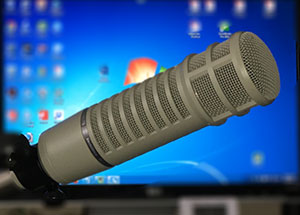
Here is my review of the EV RE20 mic. It is now my go-to vocal mic. So that’s sort of a spoiler about what I think of this fabulous :-).
So I just finished testing out the Electro-Voice RE20 Dynamic Microphone, another fabulous vocal mic that I’ve been wanting to get my hands on for a long time. The other large diaphragm dynamic was the Shure SM7B, which I reviewed last week).
Like the SM7, the EV RE20 is an end-address (you talk into the end and not the side, as with most large diaphragm condensers) dynamic mic found most often in use by radio DJs and other broadcasters. Also like the SM7B, the EV RE20 has a “cardioid” pickup pattern, which means it is most sensitive to what is directly in front of it, while rejecting sound from the rear. If you want to review mic pickup patterns, see my article Directional and Omnidirectional Microphones – What Are They Good For?
Why A Dynamic Mic For Vocals?
[Ken explains – in probably a few more paragraphs than necessary – the answer to the above question. If you don’t care, and would rather just skip to the stuff about how the mic sounded, click here:)]
Yes, typically you’d be told to use a large diaphragm condenser microphone (LDC) for vocal recording. That’s because those mics are super sensitive and can pick up the nuances of a voice really well. Also, compared to your average dynamic microphones like the standard computer mics, headsets and ice-cream cone shaped mics you see on stage for live performances, you can get better vocal quality in a recording at a really decent price. Entry-level LDCs often cost under 100 bucks.
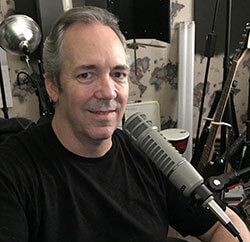 For studio recording, dynamic mics are normally used only for things like drums or loud electric guitar amps. Dynamic mics are generally less sensitive than condenser mics. And while there are exceptions of course, vocals are almost never recorded in the studio with dynamic mics. Condenser mics are widely regarded as the mics of choice of the voice recording world.
For studio recording, dynamic mics are normally used only for things like drums or loud electric guitar amps. Dynamic mics are generally less sensitive than condenser mics. And while there are exceptions of course, vocals are almost never recorded in the studio with dynamic mics. Condenser mics are widely regarded as the mics of choice of the voice recording world.
Dynamic Mics For Recording Vocals?
However, because LDCs are so sensitive, they are infamous for being TOO sensitive to plosive sounds – the little blasts of air that come out of our mouths when we say words with Ps (and sometimes Bs) in them. This results in unpleasant low-frequency/bassy “splats” in the recording. We usually call these “p-pops.”
This makes it basically mandatory to use something called a pop-filter or a pop screen when recording vocals with an LDC mic. These are those round things with fabric (typically) stretched around them – sometimes they’re made of metal – that are placed between the mouth and the microphone. Pop filters help to prevent p-pops, but they do not eliminate them for most people. Personally, I end up having to edit out every plosive I utter in a vocal recording – even when I DO use a pop filter – which can take a really long time.
Dynamic mics, on the other hand, are often less sensitive. So they are also better at preventing p-pops from getting onto your vocal recordings. The problem is that most dynamic mis just don’t sound as good when recording in the studio. But there ARE some dynamic mics that DO sound great on vocals. They just aren’t quite as affordable as a lot of decent LDCs. The kinds of dynamic mics I’m talking about are the ones typically used by radio DJs and other broadcasters. The Electro-Voice RE20 dynamic microphone is one of those.
So How Did It Sound?
One word – Awesome. I said the Shure SM7B (another broadcast quality dynamic mic) sounded great on my voice. And it does. But the RE20 sounds better. I was pleasantly surprised. But here is the best part. Even without a pop filter, the p-pop/plosive problem was almost non-existent! That was my one quibble with the SM7B. Though it was not as sensitive to plosives as my Rode NT2-A (an LDC mic), there were still quite a lot of p-pops with the SM7. But the RE20 really shines in this very specific, but very important matter. In the RE20 audio recording below, there were a couple of p-pops still. I recorded all samples with my mouth 3 inches away from the mic so they could be fairly compared. But when I backed my mouth away just another inch or two, the p-pops were gone.
The lack of p-pops in the RE20 recordings means saving a ton of time when producing any vocal recording, since I won’t have to painstakingly scrub through and edit just about every word with a “P” in it. Given the amount of time I normally spend doing plosive-hunting, this is a real game changer for me!
Take A Listen To The Audio Samples
Whether one mic “sounds better” than another can often be quite subjective. And truth be told, a mic that sounds fabulous on one person’s voice can sound bad on someone else’s voice. And honestly, all three of these mics are very good!
So with that in mind – after listening to my voice in the RE20, and then comparing the audio of the same text recorded with 2 other mics (my usual Rode NT2-A and the Shure SM7B), I felt that my voice sounded better with the RE20. But for a sanity check, I asked my wife – the lovely and talented Lisa Theriot – to come up and do a “blind” (deaf?) listening test. She ranked them the same way I did: the RE20 sounded best, the SM7B was 2nd place, and the Rode NT2-A was third place.
Have a listen to the samples below. I highly recommend using headphones to hear the subtleties. Also, none of the recordings were edited for p-pops.
First is the Rode NT2-A on “cardioid” setting WITH a pop filter (the sE Electronics meta l pop filter).
The next sample is of the excellent Shure SM7B wearing it’s foam windscreen, but without an extra pop-filter:
And finally we have below the recording made with the RE20. There was no pop filter of any kind used on this recording:
That Was The Good – Was There Any Bad?
My only quibbles are so minor as to be negligible. But I thought I should mention them. First, the RE20 comes with no manual. In the box is only a sheet with features and specs and the standard warranty paperwork. Now you may wonder why anyone would need a manual for a mic.
Well for starters, it would be nice to know about the bass roll off feature. The is a switch at the bottom of the mic that has a horizontal line on one side and a 45-degree angled line on the other. I can GUESS that this is a bass roll-off feature. But what frequency is used to start the roll off?
Eventually I found it mentioned in the extremely fine print under the “Architects’ and Engineers’ Specifications” section. It read: “when the filter switch is in the “on” position, low frequency response shall tilt down 4.5 dB from 400 to 100 Hz.” That information should have been much easier to find.
My other quibble is that the mic came only with a plastic mic stand clip. That isn’t all that uncommon, but compared to the SM7B’s built-in bracket mount that buffers the mic from vibrations in the stand, it was a bit disappointing.
It actually became a problem when, out of habit, I connected the mic to my desk-mounted boom stand. I did a few recordings that seemed to have a bit too much bass in them. Then I realized that without a “shock mount” every vibration on my desk was traveling right up the mic stand and into the mic. My desk had essentially become part of the mic.
So I moved the mic to a standard mic stand that sat on the carpeted floor, and things became MUCH better. Since the RE20 is so often depicted hanging from desk mounted boom stands in radio stations, it’s important to know that you need the 309A suspension shock mount, which you must buy separately, if you plan to mount it this way.
Specs And Other Good-To-Know Stuff
You can view the really detailed specs on the Electro-Voice site. But here are the highlights.
- It’s a “true cardioid with no coloration at 180-degrees off-axis.” This means that even if you angle the mic partially away from the source, you’ll get the same sound as if you pointed the mic straight at it. This is GREAT news for vocalists, who can reduce any risk of p-pops and even harsh “S” sounds, just by speaking/singing into the mic at a slight angle.
- The frequency response is 45 – 18,000 Hz.
- It’s “variable-D.” Yeah, I didn’t know what that meant either. In a nutshell, it means there is no proximity effect, which is amazing for a “cardioid” mic. With most cardioids, the closer your mouth (or whatever audio source) gets to the mic, the “bassier” (more low frequencies) the audio sounds. And since it’s bass that causes p-pops, the lack of proximity effect means you can get your mouth close to the RE20 without the bass frequencies getting hyped.
- Though the RE20 is described and known as a “broadcast announcer” microphone, it can sound great in other situations as well. The Features sheet mentions that it shines on instruments, specifically acoustic guitar, and as a kick drum mic.
Final Word
I want one. Okay, that’s tree words. Whatever:). In fact I am going to buy one for a Spring present. That’s a thing, right?:-P. Seriously, as much voice-over and singing recording as I do, the superior sound combined with the rejection of ambient noise and p-pops make this mic almost a necessity! At least that’s what I’m telling the lovely and talented Lisa Theriot:-). UPDATE: I did that. The RE20 is my daily mic now.
To get your very own Electro-Voice RE20, CLICK HERE.
I won’t tell:).
A Plugin To Eliminate Feedback From Your PA
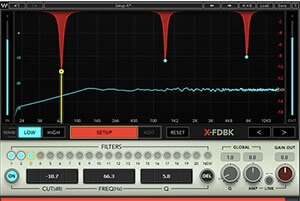 Every now and again we like to share stuff about live performance. this is mostly for musicians, but can also be useful for anyone using a PA for a live performance – magicians, actors, events with people speaking, etc.
Every now and again we like to share stuff about live performance. this is mostly for musicians, but can also be useful for anyone using a PA for a live performance – magicians, actors, events with people speaking, etc.
When I play live music with a PA system (sometimes we play small gigs without a PA), feedback is ALWAYS an issue. And there isn’t always a professional “sound guy/gal” in the back of the room that knows what to do about it, or has the gear to do it if they did. So what normally happens? The overall volume gets turned down and down until the feedback goes away. And this works, except for the fact that you might not be able to get your sound loud enough now.
Here is the basic problem. Sound is coming through the speakers and some of it comes back through the microphone to cause the problem. But it’s not ALL the frequencies (see my article-with-video on EQ and frequencies to learn more about THAT – What is Equalization, Usually Called EQ?) It’s usually only 1 or a couple of VERY narrow frequencies that are sort of getting trapped in the system and amplified over and over again until they overload the system AT JUST that frequency.
If we could turn down JUST that very specific and narrow frequency at a the source – which starts with making sure the mic is not facing the speakers, but after that is at the mixing board – we could eliminate the feedback. The tool needed at a mixing board is an equalizer, or EQ for short. You let the feedback ring and try turning down all the frequency volumes until you find the one responsible.
The problem with the EQ approach is that most mixing boards don’t have controls for enough frequencies! What do they usually have? You most often find 3 controls – one for bass frequencies, one for middle frequencies, and one for high frequencies. That is not enough precision. You really need at least like a 30-band graphic EQ that gives you controls at 31 different frequencies (actually frequency “bands”) from low (bass) to high.
So what you’re left with is the only option, which is to turn down ALL the frequencies (usually with the master volume knob/fader) until the feedback goes away. It seems a waste of available volume to tell all the frequencies to be quiet when only one or two of them are making trouble.
Even with the a 30-band EQ though, it can be difficult, not to mention loud for everyone in the room, to locate the correct frequency. And once you find the first one, there may be a second or third ready to cause more feedback. Wouldn’t it be cool if you had something that could immediately detect what frequencies were feeding back, and then immediately reduce the volume of JUST those frequencies? The correct answer is yes:).
And guess what? There is a tool that can do that. You’d need to have a computer at the mixing station. Maybe you’re using a computer to do all your mixing, which is possible now of course. But the Waves X-FDBK Feedback Eliminator is exactly the right tool for doing what I just described.
Below is a video showing how X-FDBK works:
You can find out more or buy the plugin from Waves Audio here.
EQ Tip For Creating A Wider Stereo Sound
 EQ (equalization) is an incredibly useful tool when mixing music. For the main reasons why, see my article (and video) What is Equalization, Usually Called EQ? You can do so many things with EQ, which is probably the most underutilized audio editing tool there is – at least in the mixing realm.
EQ (equalization) is an incredibly useful tool when mixing music. For the main reasons why, see my article (and video) What is Equalization, Usually Called EQ? You can do so many things with EQ, which is probably the most underutilized audio editing tool there is – at least in the mixing realm.
Here is a cool tip for enhancing the stereo imaging – making things sound even wider and larger in your mix – from The Disc Makers Blog: http://blog.discmakers.com/2016/04/complimentary-eq-home-studio-audio-mix/
And here is the video to accompany the above article:
Review Of The Shure SM7B Dynamic Vocal Microphone
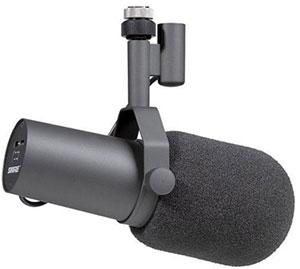
I’ve been wanting to get my grubby little hands (he actually wears X-Large gloves) on a Shure SM7B dynamic microphone to review for Home Brew Audio for quite awhile. And last week I landed one. Yes!
This mic is designed specifically for vocals. And what makes it so special for me is that unlike most of the vocal microphones I talk about for studio vocal recording, the SM7B is a dynamic microphone (as opposed to a condenser mic – check out my article What Is the Difference Between Condenser and Dynamic Microphones? for a review of what that means).
For this review, I put The SM7 to the test, comparing it to my studio workhorse, the Rode NT2-A large diaphragm condenser (LDC) microphone. In addition to the audio recordings of that comparison, I recorded my voice both with and without the SM7’s supplied A7WS windscreen, which Shure describes as being “for close-talk applications, such as voice overs or radio announcements.” The A7WS is an alternative to the standard thinner screen that the mic usually wears. I also recorded a sample with the bass roll off switch engaged (Yup it has one. I didn’t know either!).
So what did you think already?
One of the first things I noticed when I opened the box was the way the bracket was already attached to the mic. This was good news. Having only seen the mic in pictures, hanging from its yoke-shaped bracket, I thought it was going to be difficult to set it up. But it turned out to be super simple, much easier than any of the shock mounts you have to deal with when setting up large diaphragm condenser (LDC) mics.
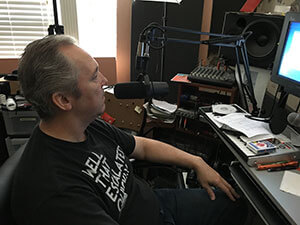
The mic itself is a large, heavy and very sturdy piece of kit. Like most dynamic mics, the SM7 is an “end-address” mic, meaning you talk into the end of the cylinder. This made it much easier for me to see my computer screen when speaking into the mic as it hung from my desk boom stand. See figure 2. It’s pretty hard to see around my side-address Rode LDC mic, with its mandatory pop-filter.
Also, the SM7 is a cardioid mic, which means it’s a directional mic, picking up best what is directly in front of it, and rejecting sound from the rear. For a review on mic pickup patterns, see my article Directional and Omnidirectional Microphones – What Are They Good For?
Anyway, I was anxious to record my voice with the SM7, so I wrote a quick script so I could record the exact same thing with both mics and all the different configurations of the SM7.
The audio samples
Below are all the recordings I made for this review. I highly recommend listening to them with headphones if you can. That will allow you to hear subtle differences more clearly. Pay particular attention to the p-pops in all the recordings. IMPORTANT: I purposely did not edit ANY of the plosives/p-pops in these recordings, since one of the main advantages of using a dynamic mic should theoretically be fewer p-pops in the recording. All recordings were made with the mic plugged into my Focusrite 2i2 audio interface. Because the SM7 is a dynamic mic, you should turn OFF the phantom power on your interface units.
First I recorded as I normally do – using my rode NT2-A on cardioid setting with an sE Electronics metal pop filter. Below is what that sounded like:
Next I recorded the same script with the SM7B. Below is that sounded like:
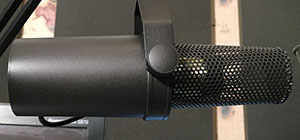
For the third test recording, I removed the standard (thinner) wind screen from the SM7 and put the thicker A7WS windscreen onto the mic. I took a picture of what the mic looked like with no windscreen at all (you should not record without a windscreen of some kind, BTW) while I was changing the screens. See Figure 3. Once the A7WS was on, the mic looked like it does in the fist picture at the top left of this page. Theoretically, this recording should not have had as many pop-pops as either of the previous two recordings. I’ll let you be the judge. Take a listen to that sample below:
The thing I almost missed
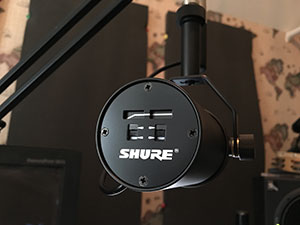
I had already finished (I thought) the recordings for this review when I read something in the manual that surprised me. Apparently there are two switches on the SM7B – a bass roll off switch and a mid-range emphasis (presence boost) switch. On every other mic I’ve ever used, any tone switches are clearly visible right on the body of the microphone. But the SM7B body is a smooth as a baby’s bottom. No switches. I had to read the fine print to find out where these switches were. It turns out they are on the back end of the mic. See figure 4.
I definitely wanted to record a sample with the bass roll off switch engaged, but I couldn’t figure out how to move the switch! I couldn’t do it with my little finger, which is usually how these things are done. The manual had nothing to say on the matter. I ended up looking at a forum on the internet before I discovered that others usually use the tip of a small screwdriver or a paper clip. I grabbed a small paperclip and with the curved end was able to move the switch. THAT was an unexpected difficulty.
Anyway, the reason I wanted to flip the switch is that “rolling off the bass” reduces the sensitivity of the mic in the bass frequencies. Since p-pops live in the bass range, I hoped I could get a nice rich sound AND be totally p-pop free with this switch turned on. I was half right. The p-pop problem virtually vanishes on this setting. But the reduced bass in the recording sort of takes the richness away also. This will vary from voice to voice. So your mileage on this score may vary.
The below recording has the bass roll off switch engaged AND the A7WS windscreen on the mic:
Overall impressions?
I was impressed with how great the Shure sounded compared to the more expensive Rode NT2A ($399). Just to be sure (ha!) I wasn’t imagining it, I asked my wife, the lovely and talented Lisa Theriot, to come up and do a blind test of the recordings. Without knowing what recordings she was listening to, she chose the SM7B (though NOT the sample with the bass roll off switch on) as the best sounding audio by a significant amount. For her, the difference was very clear. She described the SM7 audio as rich and “chocolate-y”:).
She chose the SM7B as the best sounding audio by a significant amount. For her, the difference was very clear. She described the SM7 audio as rich and “chocolate-y”:).
I heard the difference also. Besides the overall sound being better, the p-pops were certainly reduced with the Shure, though I was hoping that they would be close to non-existent. Some p-pops still came through on the SM7 recordings, even though as a dynamic mic it theoretically should have been much less sensitive to the plosives. But then again, I’ve noted in the past that my “Ps” are made of stronger stuff than many folks. I think my expectations in this area may be a tad unreasonable. It will be interesting to hear how another popular dynamic mic – the Electrovoice RE20 – sounds in next week’s review:).
One other huge plus of this mic is how quiet the background nose is! This is a double-bonus for folks recording voice-overs in the standard boxy room at home. Not only does the cardioid pickup pattern reject noise from most of the room, but the lower sensitivity of a dynamic mic helps reduce any background noise even more, improving the sound quality of your home recordings.
The Shure SM7B is an amazing microphone. I never knew a dynamic mic could sound so good. It’s perfect for voice-over actors, podcasters, or anyone recording vocals. It is incredible at not picking up extraneous noises in the background, so it’s almost tailor-made for folks who record vocals at home in less than ideal acoustic rooms. The SM7B costs $349, which is a bit higher than your entry-level LDC mics. But for the quality and features you cannot go wrong with this microphone. CLICK HERE to find out more or to order one of your own.